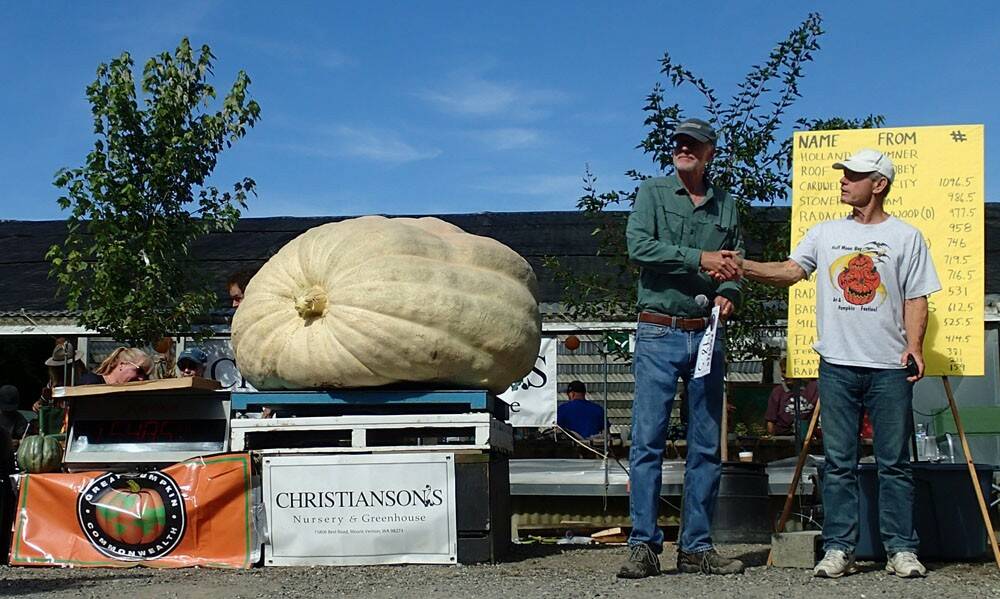While some go to the gym to lose weight and pursue the so-called “beach body,” all it takes to achieve the perfect harvest bod is sitting around and putting on pounds. For a North Whidbey pumpkin, that looked like 32 pounds per day.
Last Saturday, Lee Roof’s pumpkin was crowned the heaviest gourmand out of 15 other giant Pacific Northwest gourds at the 14th annual Skagit Valley Giant Pumpkin Festival in Mount Vernon.
A crowd of farmers and curious visitors that gathered at the Christianson’s Nursery & Greenhouse on the last day of summer marveled at the sight of giant pumpkins being moved onto a scale with the help of a forklift and some escorts.
Starting from the bottom of a list ranking the largest pumpkins in the game, Roof (who also emceed the event) summoned each grower to reveal the gourd’s actual weight in front of the audience. The race for the top spot came to Roof and Joel Holland, a grower from Sumner who broke the U.S. record with a 2,363-pound pumpkin at the Safeway World Championship Pumpkin Weigh-Off in 2017.
Despite being the second largest pumpkin in the competition, Roof’s 1,548.5-pound giant was revealed to be 197.5 pounds heavier than Holland’s and the heaviest pumpkin in the bunch.
As Roof said in an interview, weight is what truly matters in the world of giant pumpkin growers. But no matter the level of experience and skill of a grower, some pumpkins may simply grow more in size than density for reasons he said are unknown.
When a pumpkin weighs more than predicted based on measurements, it’s classified as “heavy,” which was the case for Roof’s pumpkin. When it weighs less, it’s “light.”
Roof, a retired physician, has won various weigh-off competitions in Western Washington with his gourds born and raised in his backyard on Penn Cove Road. His personal record is 1,706 pounds, which earned him first place at a competition on Camano Island two years ago.
His passion for growing pumpkins started almost three decades ago, when Roof stumbled upon bags of giant pumpkin seeds at a hardware store. At first, he said, it was a fun activity to share with his young children. Over the years, his interest grew, motivating him to better educate himself about the art of growing pumpkins and eventually co-founding the Whidbey Island Giant Pumpkin Contest, a 20-year tradition that ended about a decade ago.
His wife, Irene Puhr, has been supportive of the hobby. Roof likes to remind her that she should be grateful he is always outside in the yard instead of drinking at a bar or chasing other ladies.
“I kind of agree,” she laughed.
Roof said he has no expectations of becoming a world champion. Growing regional winners near the ocean without relying on a greenhouse — which he said would be too expensive to build and maintain — is difficult enough.
“I am constantly battling colder temperatures compared to a lot of my competitors,” he said. This less-than-ideal weather, however, is part of what makes this hobby so appealing, stimulating his problem-solving skills and attention to detail.
“It’s more than just putting a seed on the ground and just walking away,” he said. “There’s a lot of mental and physical work that goes into it.”
The process begins in April, when Roof plants the giant pumpkin seeds in a one-gallon pot kept indoors. Once the vine outgrows the pot, he moves it outside under a cloche. Around mid- to late June, Roof pollinates the flowers by hand.
Once a pumpkin starts to grow, Roof keeps the fruit warm by placing it under a tarp and a small space heater. At peak growth, his latest pumpkin gained 32 pounds each day, reaching 190 inches — or over 15 feet — of circumference, he said.
For best results, Roof recommends growing only one pumpkin per vine to increase the chances of growing a big one. Additionally, he said, a giant pumpkin needs loamy soil, protection from the weather, good fertilizer, water everyday for a slow and steady growth and last but not least, good seeds.
According to Puhr, her husband uses the seeds developed by the late giant pumpkin breeder Howard Dill. While visiting her family in Nova Scotia “a long time ago,” Roof got to meet the man known as “The Pumpkin King” and “the Father of All Pumpkins.”
Contrary to common belief, Roof said, injecting milk into pumpkins isn’t effective. While some say the nutrients in milk make pumpkins grow larger and heavier, some experts say it can lead to rot, according to Popular Science.
While giant pumpkins can produce good seeds to grow more giant pumpkins, Roof said the meat is not tasty and too tough to cook and eat. However, they’re a good snack for pigs, goats and other farm animals.
Roof’s pumpkin will be displayed at the Christianson’s Nursery until the end of October. After that, he said, the seeds will be harvested and sold.


